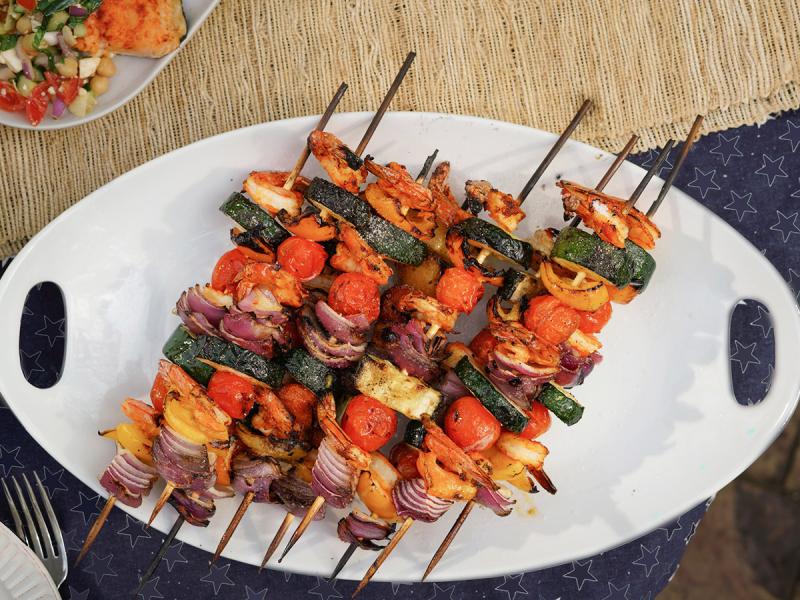As the weather cools and football season kicks off, tailgate parties provide the quintessential outdoor venue to catch up with friends over food and drinks. They’re also a great excuse to Eat Seafood, America! Incorporate fresh local seafood into classic party dishes or try out a new recipe inspired by a rival team’s region. As you plan your next tailgate menu, keep U.S.-produced seafood in mind for healthy and sustainable protein. Check out some of the following recipe ideas from our partners for inspiration!
Start with Some Fish in Dips
Dips and spreads can be adapted to a wide range of seafood options. Prepare these the night before and refrigerate them overnight. Then break them out with crackers, toasts, or chips as the party gets started for folks to snack on while other food prep continues.
Salmon spreads are a party staple in the Pacific Northwest and easily dressed up with a garnish of beets and quick pickles. Canned salmon is widely available and great for these kinds of dishes.
If you live on the East Coast, there are many variations of smoked fish dip made with regional favorites. Try local black sea bass fillets to feature in a dip with fresh tarragon. Black sea bass are caught from Massachusetts to Florida and are generally available year-round.
Try Tailgate Takes on Seafood Classics
Some tailgate enthusiasts determine a menu around the regional cuisine of one of the teams. Try some appetizers and sides that adapt regional seafood classics to a tailgate setting. Even better, you can do most or all of the prep ahead of time! Pack the prepared servings carefully in a cooler and just reheat them at the game on a portable stove.
Jambalaya is practically a requirement at Louisiana tailgates, and it can be made with a wide range of seafood and other proteins in a variety of combinations. Making it with sustainably managed U.S. wild-caught shrimp and U.S.-farmed eastern oysters is a tasty way to spice up your menu. Many oyster farms now offer home delivery!
Crab cakes are a perennial favorite in the mid-Atlantic. But if you’re in a pinch or just looking for something different, fish cakes with canned tuna are easy and affordable.
You’ll score lots of points with your friends and family by featuring U.S.-caught sushi-grade ahi tuna in Hawaiian-inspired mini poke bowls. “Ahi tuna” can mean either yellowfin tuna or bigeye tuna, but both are harvested sustainably in U.S. waters. Prepare the poke bowls with their non-seafood ingredients at home and transport the uncooked ahi separately on ice. You can finish the assembly once you arrive and are ready to serve.
Fire Up the Tailgate Grill
Lastly, for a seafood-spectacular main course, consider options that are easy to eat without plates or utensils. Grill your favorite white fish in Cajun seasoning and serve it in tacos. Or add your favorite barbeque sauce to grilled salmon for a seafood take on BBQ sandwiches. Skewers provide another classic utensil work-around. They’re easy to prepare, easy to eat, and even easier to clean up! Plus, you can pack them tight with tasty grilled vegetables!
More tips for grilling seafood
- Cajun Grilled White Fish Tacos
- BBQ Wild Alaska Salmon Sandwiches
- Easy Shrimp Skewers (with veggies)
- Grilled Alaska Rockfish Kebabs with Chimichurri Sauce
Keep it Cold, Keep it Safe
This year it may make sense to host your tailgate party in your own backyard, with easy access to your refrigerator and freezer. But if you’re planning a traditional tailgate in the lot outside the stadium, be sure to follow best practices for transporting and serving seafood safely:
- Sterilize your cooler before packing it with seafood
- Store pre-prepared seafood dishes on ice or cold packs until ready to eat or reheat
- Keep raw seafood and cooked seafood separate
For additional information, see the U.S. Food and Drug Administration’s guidelines for seafood safety at picnics and parties.
Team U.S. Seafood
Whichever team you plan to support during the game, you can support sustainable seafood by purchasing fish caught or farmed in the United States. NOAA Fisheries and FishWatch arm you with the facts about what makes U.S. seafood sustainable—from the ocean or farm to your plate. Get up-to-date information on the status of harvested marine fish and farmed fish, and learn more about U.S. seafood.







